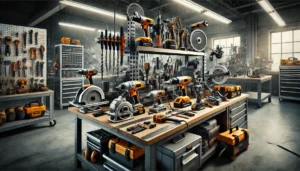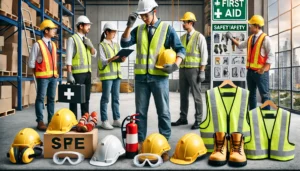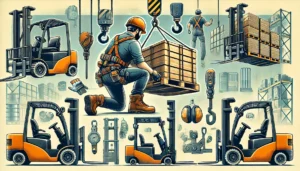Choosing the right anchor is important for safety and stability of heavy-duty industrial applications. Anchors are implemented to hold structures by transferring the load to a base material such as concrete, brick or stone. Environmental conditions, load requirements for anchors, and the specific materials determine their selection. We present a list of the ten best industrial anchors that are heavy-duty.
1. Wedge Anchors
Wedge anchors are expansion or mechanical type anchors that are effective in solid concrete applications. It is a working bolt having a threaded stud and a conical expansion clip. The clips are held securely against the concrete once the nut is tightened. Structural work like attaching steel columns, beams and heavy machinery often utilizes wedge anchors. They are preferred in construction and industrial works due to their high load bearing capacity and reliability.
2. Sleeve Anchors
Expansion anchors that are used in diverse materials like concrete, bricks, and blocks are called sleeve anchors, and they are incredibly versatile. The main part comprises a sleeve which contains a bolt. When the bolt is fastened, the sleeve pushes against the base material, enabling the anchor to hold firmly. Light to medium weight fixtures like handrails, window frames, and even electrical boxes can be secured with sleeve anchors. They can also be used in different bases, which increases their value in different applications.
3. Drop-In Anchors
Drop-in anchors are designed for solid concrete installations which require a flush expansion anchor. These anchors provide internal threads and a cylindrical body that contains an expansion plug within. To set the anchor, one must drill a hole into the concrete slab, insert the anchor into the hole, and use a setting tool to push the plug down which expands the anchor and locks it in place. Drop-in anchors are ideal for overhead applications, especially for hanging piping, ductwork, or suspended ceilings because they require a flush surface.
4. Lag Shield Anchors
Lag screws are used with lag shield anchors which are made for concrete or mortar jointed brick/block wall constructions. These anchors are installed in base materials with internal threading and get expanded with a lag screw when inserted. These types of anchors are perfect for medium and heavy duty applications like installation of equipment onto the wall or setting up shelving and structural supports. These same anchors are equally easy to uninstall making them useful for projects where disassembly is needed.
5. Machine Screw Anchors
Machine screw anchors are designed for light to medium duty purposes and therefore have internal threading. These types of anchors are mounted using machine screws and are helpful in securing fixtures to base materials such as concrete, brick, and block. The installation procedure involves setting the anchor in a pre-drilled hole and then expanding it with a setting device. Machine screw anchors are mostly used in situations where the attached fixture is to be taken out and fixed back continuously, for instance, in electrical installations or in mounting equipment.
6. Concrete Screw Anchors
A concrete screw anchor is a type of fastener also referred to as a masonry screw. It is a threaded tool made for direct fastening to concrete, brick, or blocks. Anchors like these offer medium-duty services for fixtures such as light fixtures, electrical boxes, and furring strips. Concrete screw anchors are easy to install and even easier to remove, which makes them an indispensable component for various projects. A pre-drilled hole is a prerequisite for these screws. As the concrete screw anchor is drilled in, threads are cut into the base material.
7. Heavy-Duty Toggle Anchors
Heavy-duty toggle anchors are designed for use in hollow materials such as concrete block and drywall. They consist of a machine screw and a spring-loaded toggle that expands behind the base material, distributing the load over a larger area. Heavy-duty toggle anchors are ideal for mounting heavy fixtures, such as shelving units, brackets, and handrails, where traditional anchors may not provide sufficient holding power.
8. Adhesive Anchors
A tensioned rod or rebar is bonded into a drilled hole using a resin-based adhesive material called adhesive anchors. These work particularly well with heavy-duty applications and are referred to as chemical anchors as well. From concrete to masonry, they are suitable for all solid and hollow materials. They are commonly used for precise structural applications that need substantial load supporting structures like bridging bearings, steel columns, and seismic retrofitting.
9. Cast-in-place Anchors
These anchors are positioned once the mold is set up but prior to pouring in the concrete mix. Cast-in place concrete aids in integrating the anchor tightly into the structure once it hardens as an essential building block. It consists of a threaded rod, bolts, or other anchoring element that is inserted into the formwork before the concrete is placed. The degree of strength and stability is utmost essential in a few applications such as anchoring, steel, and heavy machinery bases which is why cast-in-place anchors are the perfect solution.
10. Earth Anchors
As the name suggests, earth anchors are intended to be set in earth. Their purpose is to provide anchorage in soil or other ground materials. Their use ranges from securing guy lines for towers to stabilizing retaining walls and also anchoring structures that are prone to uplift forces. Earth anchors are one of the solutions for heavy duty anchoring needs from geotechnics and construction. They are also installed easily by just driving or screwing them into the ground.
Conclusion
In conclusion, making the right choice of anchor to be used for heavy duty industrial applications will require you to weigh the base material, load requirements, environmental conditions, and installation methods. Each anchor type is suited particularly for some set factors and situations and none other. With this knowledge on the top best industrial anchors available to these professionals, they will know the right decision to make for the safety and stability of the structure and installation and the longevity of the structure too.










